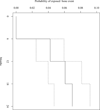Exposed bone in patients with head and neck cancer treated with radiation therapy: An analysis of the Observational Study of Dental Outcomes in Head and Neck Cancer Patients (OraRad)
- PMID: 34665873
- PMCID: PMC8776577
- DOI: 10.1002/cncr.33948
Exposed bone in patients with head and neck cancer treated with radiation therapy: An analysis of the Observational Study of Dental Outcomes in Head and Neck Cancer Patients (OraRad)
Abstract
Background: Patients with head and neck cancer (HNC) treated with radiation therapy (RT) are at risk for jaw osteoradionecrosis (ORN), which is largely characterized by the presence of exposed necrotic bone. This report describes the incidence and clinical course of and risk factors for exposed intraoral bone in the multicenter Observational Study of Dental Outcomes in Head and Neck Cancer Patients (OraRad) cohort.
Methods: Participants were evaluated before RT and at 6, 12, 18, and 24 months after RT. Exposed bone was characterized by location, sequestrum formation, and other associated features. The radiation dose to the affected area was determined, and the history of treatment for exposed bone was recorded.
Results: The study enrolled 572 participants; 35 (6.1%) were diagnosed with incident exposed bone at 6 (47% of reports), 12 (24%), 18 (20%), and 24 months (8%), with 60% being sequestrum and with 7 cases (20%) persisting for >6 months. The average maximum RT dose to the affected area of exposed bone was 5456 cGy (SD, 1768 cGy); the most frequent associated primary RT sites were the oropharynx (42.9%) and oral cavity (31.4%), and 76% of episodes occurred in the mandible. The diagnosis of ORN was confirmed in 18 participants for an incidence rate of 3.1% (18 of 572). Risk factors included pre-RT extractions (P = .008), a higher RT dose (P = .039), and tobacco use (P = .048).
Conclusions: The 2-year incidence of exposed bone in the OraRad cohort was 6.1%; the incidence of confirmed ORN was 3.1%. Exposed bone after RT for HNC is relatively uncommon and, in most cases, is a short-term complication, not a recurring or persistent one.
Keywords: head and neck cancer; jaw osteonecrosis; osteonecrosis; osteoradionecrosis; radiation therapy.
© 2021 American Cancer Society.
Conflict of interest statement
The authors declare no relevant conflicts of interest.
Figures
References
-
- American Cancer Society. American Cancer Society: Cancer Facts and Statistics [Available from: https://cancerstatisticscenter.cancer.org/?_ga=2.214893202.42047244.1569....
-
- Marur S, Forastiere AA. Head and Neck Squamous Cell Carcinoma: Update on Epidemiology, Diagnosis, and Treatment. Mayo Clin Proc. 2016;91(3):386–96. - PubMed
-
- National Cancer Institute. Head and Neck Cancers 2017. [Available from: https://www.cancer.gov/types/head-and-neck/head-neck-fact-sheet#how-are-....
-
- Parliament M, Alidrisi M, Munroe M, Wolfaardt J, Scrimger R, Thompson H, et al. Implications of radiation dosimetry of the mandible in patients with carcinomas of the oral cavity and nasopharynx treated with intensity modulated radiation therapy. Int J Oral Maxillofac Surg. 2005;34(2):114–21. - PubMed
Publication types
MeSH terms
Grants and funding
LinkOut - more resources
Full Text Sources
Medical


